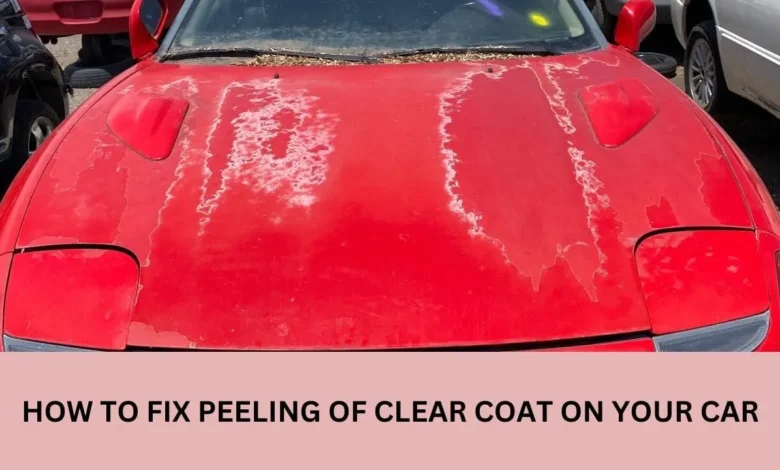How to Fix Peeling Clear Coat Without Repainting

Introduction Clear coat peeling
Clear coat peeling is a common issue that many car owners face, especially as vehicles age or are exposed to harsh environmental conditions. The clear coat is the transparent protective layer applied over a car’s paint to provide shine, protection from UV rays, and a smooth finish. Over time, factors such as prolonged exposure to sunlight, improper washing techniques, Clear coat peeling and general wear and tear can cause the clear coat to peel or flake off. While repainting the affected area is one option, it can be expensive and time-consuming. Fortunately, there are methods to fix peeling clear coat without resorting to a full repaint. In this detailed guide, we’ll walk through the step-by-step process, tools required, and tips to achieve professional-looking results at home. Clear coat peeling

To address peeling clear coat without repainting, it is essential to first understand the extent of the damage. The peeling might appear as small, Clear coat peeling localized patches or as larger areas where the clear coat has lifted entirely. The severity of the damage determines the tools and techniques you will need to restore the finish effectively. Start by inspecting your car under good lighting to identify all affected areas. Once you’ve identified the problem spots, gather the necessary materials. You will need sandpaper in various grits, a polishing compound, rubbing alcohol, Clear coat peeling microfiber cloths, a tack cloth, automotive masking tape, and a can of automotive clear coat spray. Having all these supplies ready ensures a smooth workflow and saves time during the process. Clear coat peeling
Before starting the repair, preparation is key. Clear coat peeling Wash the car thoroughly using a mild automotive soap to remove dirt, grime, and grease. A clean surface ensures better adhesion of the new clear coat and minimizes the risk of imperfections during the repair process. Once the vehicle is clean, dry it with a microfiber towel, making sure no water spots remain. Clear coat peeling Avoid working in direct sunlight or on a hot surface, as heat can interfere with the application of clear coat and other materials. A shaded, well-ventilated area is ideal for this task. Clear coat peeling

The first active step in fixing peeling clear coat involves sanding the Clear coat peeling affected area. Begin by masking off the surrounding areas with automotive masking tape to protect the undamaged paint. Use a fine-grit sandpaper, such as 2000-grit, to gently sand the edges of the peeling clear coat. This step is crucial because it smoothens the transition between the damaged area and the surrounding clear coat. Sand in a circular motion, applying light pressure Clear coat peeling to avoid removing the paint beneath the clear coat. For stubborn edges or larger peeling sections, start with 1500-grit sandpaper and gradually move to finer grits for a polished finish. As you sand, periodically wipe the area with a damp microfiber cloth to remove dust and check your progress.
Once the edges are feathered and smooth, Clear coat peeling clean the area thoroughly with rubbing alcohol or a degreaser. This step removes any residual sanding dust, oils, or contaminants that could interfere with the adhesion of the new clear coat. Use a tack cloth to pick up any remaining fine particles, ensuring the surface is completely clean. Take your time during this step, as a well-prepared surface is critical for achieving a flawless finish. Clear coat peeling
After prepping the area, it’s time to apply the new clear coat. Clear coat peeling Shake the can of automotive clear coat spray thoroughly to mix the contents evenly. Hold the spray can about 6-8 inches away from the surface and apply a light, even coat. Start spraying slightly off the edge of the affected area and move across in smooth, overlapping strokes. Avoid applying too much clear coat in one pass, as this can lead to runs or uneven coverage. It’s better to apply multiple thin layers, allowing each layer to dry for about 5-10 minutes before applying the next. Typically, two to three coats are sufficient to restore the shine and protection of the affected area. Clear coat peeling
Once the final coat has been applied, allow the clear coat to cure for at least 24-48 hours. This curing period is essential for the clear coat to harden and bond properly to the surface. Avoid exposing the repaired area to water, dust, or other contaminants during this time. If you notice any imperfections, such as rough patches or uneven texture, don’t panic; these can be corrected during the polishing step.
After the clear coat has fully cured, the final step is to polish the repaired area. Use an automotive polishing compound and a clean microfiber cloth to buff the surface gently. Clear coat peeling Polishing smoothens out minor imperfections, enhances the shine, and blends the repaired area seamlessly with the rest of the car’s finish. Work in small sections, using circular motions and light pressure. For a more professional result, you can use an orbital buffer, but manual polishing works well for smaller areas. Clear coat peeling

Regular maintenance is crucial to prevent the Clear coat peeling clear coat from peeling again in the future. Protect your car from prolonged sun exposure by parking in shaded areas or using a car cover. Wash your vehicle with a pH-balanced automotive soap and Clear coat peeling avoid abrasive scrubbers that can damage the clear coat. Applying a high-quality wax or paint sealant every few months adds an additional layer of protection, helping to extend the life of your car’s finish. Clear coat peeling
Fixing peeling clear coat without repainting is a practical solution for restoring your car’s appearance without the expense and effort of a full repaint. By following the steps outlined in this guide, Clear coat peeling you can achieve professional-looking results at home, saving both time and money. With proper preparation, patience, and attention to detail, you can bring back the shine and protection to your vehicle, ensuring it looks its best for years to come. This method not only enhances the aesthetic appeal of your car but also maintains its resale value, making it a worthwhile investment of time and effort. Clear coat peeling



